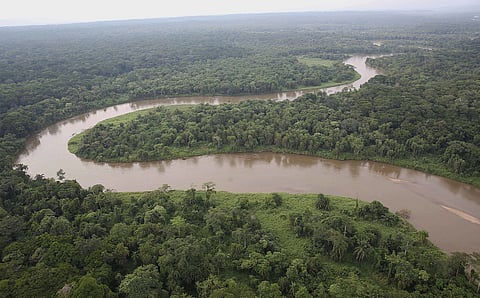

At the 16th Conference of Parties (COP16) of the Convention on Biological Diversity (CBD), currently taking place in Cali, Colombia, new data was released which shows that the world’s best and most important ecosystems are facing a threat from extractive industries. These include key biodiversity areas, high-integrity forest landscapes, protected areas, and Indigenous territories.
Maps included in a report titled Closing Window of Opportunity: Mapping Threats from Oil, Gas and Mining to Important Areas for Conservation in the Pantropics show that extraction is being carried out for oil, gas, and mining in important areas for conservation across the Amazon Basin, Congo Basin, and Southeast Asia.
The data reveals 518 Key Biodiversity Areas (KBA), which are 18 per cent of the total such areas, have active and potential oil and gas concessions.
Oil and gas blocks overlap with 14 per cent of KBAs and 12 per cent of indigenous territories by area just in the Amazon. Oil and gas blocks overlap with 40 per cent of KBA area in the Congo Basin, while mining concessions overlap with 16 per cent of KBA area. In Southeast Asia, 14 per cent of the total extent of KBAs is overlapped by oil and gas blocks.
As much as 180 million hectares of high-integrity forests are at risk in Amazon and Congo basin regions and Southeast Asia as they have ongoing and planned fossil fuel extraction projects.
Over 30 million hectares of indigenous territories in the Amazon are also impacted. Overall, in these three regions, 25.4 million hectares of protected areas are overlapped by oil and gas blocks. Several case studies in the report also show extractive expansion threats to indigenous peoples living in voluntary isolation.
These areas are rich in biodiversity and also serve as vital carbon sinks, regulating the global climate. Industrial activity in these regions can push fragile ecosystems past tipping points and adversely impact both nature and human populations.
The report was released at a press meeting. Stephen Woodley of the International Union for Conservation of Nature which was part of the group that worked on the report, said that while we are here (at COP16) talking about business ‘unusual’, having oil and gas leases and mining leases in areas we want to protect is business ‘as usual’.
He said that this report shows that the overlap is unsustainable and there is need to move to transformative change. “We are a long way off from doing ‘business unusual’,” he said.
Jennifer Corpuz of International Indigenous Forum on Biodiversity who was one of the panellists and also a partner in the preparation of the report, explained that while it is well known that indigenous territories are under threat but exact data on the magnitude and locations of these threats are not available. The new report shows this very clearly. “It provides us with good information for advancing advocacy for protection and we are going to use it as negotiations proceed,” she said.
Alice Jay of Campaign for Nature, who was also part of drafting the report, pointed out that these areas are extremely vulnerable. She pointed out that the Kunming-Montreal Global Biodiversity Framework has created a path of what to do to achieve Target 3 and its guidelines have to be followed. She said finance is important to meet the goal and urgent action is not possible unless funding targets are met too. It will require a $100 billion per year to meet the 30x30 target and donor countries should meet their commitments on finance.
Key recommendations of the report are:
Expand the global network of protected and conserved areas and restrict industrial expansion in these areas: Immediate efforts are required to designate new protected areas, prioritising regions of high biodiversity, cultural, and ecological significance and to protect these areas from industrial activity.
Respect indigenous sovereignty and provide sufficient resources for indigenous-led conservation: Provide indigenous peoples with the necessary financial, technical, and political resources to exercise governance over their territories while fully recognising and respecting their sovereignty.
Increase funding for nature conservation: Mobilise and increase funding for conservation at both national and international levels.
“Preserving nature is essential for our shared future. The land and many Indigenous and local leaders who steward it are sending a clear message…” said Tyson Miller, executive director, Earth Insight said in a press release. “We are at a crossroads: we can either act now to safeguard the natural systems that sustain life or keep on the business-as-usual train speeding towards a cliff.”